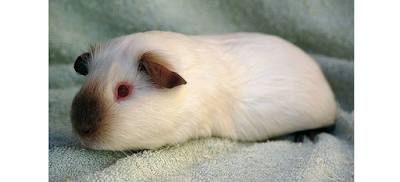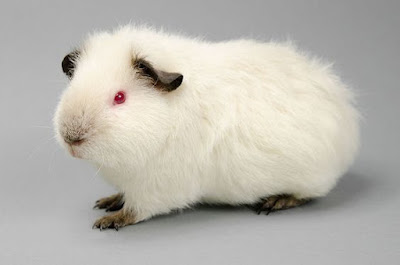The Himalayan Guinea Pig: Siamese Cats Of The Guinea Pig World
Contrary to their names, the Himalayan Guinea Pigs did not originate from Asia, but South America instead. These Cavies are also known as the Siamese Cats of the Guinea Pig empire due to their unique and distinctive colour markings!
The Himalayan Cavy
Like other breeds of Guinea Pigs, the Himalayan Cavies are descendants of the first Guinea Pigs that were brought to Europe and then North America, centuries ago. The oldest breed being the American Shorthair. They originated from South America as early as 5000 BC, and they are descendants of the Tschudi Guinea Pig.
 |
| Source |
View related:
Appearance Of The Himalayan Guinea Pig
Himalayan Cavies are known best for their unique markings, also referred to as "seal-points". Similar to Himalayan Cat and Rabbit, Himalayan Guinea Pigs have bodies that are predominantly white, accompanied with dark Chocolate points on their ears, nose and feet. Their eyes are ruby Red. Interestingly, the pigmentation of these seal-points are said to be determined by the temperature and climate of their living environment!
Fun Fact All Himalayan Guinea Pigs are born mostly White, and start developing pigmentation on their ears, nose and feet within a month. The true density of these points can be seen as they grow up to 3 months old.
 |
| Source |
Fun Fact All Himalayan Guinea Pigs are born mostly White, and start developing pigmentation on their ears, nose and feet within a month. The true density of these points can be seen as they grow up to 3 months old.
Grooming And Care Requirements
When living in a warm or frequent exposure to sunlight, the pigmentation of their seal points may begin to fade— be sure to keep them in a well-shaded space! This phenomenon is said to also be an indication of illness or trauma, so watch their colouration carefully.
Himalayans have short hair that do not require much cleaning unless they are soiled, so keep their living space clean at all times. Unscented soap may be used sparingly when giving them a quick bath, dry very thoroughly after. Replace their Hay, Water and food supplies with fresh ones while you clean up their area.
Quick Care Tips
Housing — A good and comfy home for the Himalayan or any guinea pig would be soft and quality bedding. Some owners opt for fleece towels or even hay, just ensure cleanliness at all times. Avoid Pine and Cedar wood bedding as it may lead up to respiratory issues. Straw is also not advisable for absorbency purposes.
Ensure the living space/cage is of an appropriate size, large enough for your active Cavy to run and roam about. To prevent them from eating soiled hay, clean their living space regularly and provide fresh food and water!
Ensure the living space/cage is of an appropriate size, large enough for your active Cavy to run and roam about. To prevent them from eating soiled hay, clean their living space regularly and provide fresh food and water!
Feeding — Good quality Hay is an absolute staple in a Guinea Pig's diet. Introduce a plate of hay for food with food pellets mixed in. Guinea Pigs require a ton of Fiber and Vitamin C, inclusion of fresh vegetables and occasional fruits treats are healthy. Recommendations for good quality Hay types are Timothy Hay, to encourage healthy teeth and a good digestive system.
View Related:
What Can My Guinea Pig Eat?: Guinea Pig Safe Greens and Fruits
View Related:
What Can My Guinea Pig Eat?: Guinea Pig Safe Greens and Fruits
Himalayan Guinea Pig Personality
Expect a curious, affectionate and friendly Cavy that would be a great companion with proper care and attention. It is advised to have more than one Guinea Pig due to curb loneliness. Spend a little time with them everyday, to play or be hand-fed— this builds trust. Entertain them with lots of toys and tunnels, and provide soft towels or fleece to hide in. The average lifespan of a Himalayan Guinea Pig is 5 to 8 years!
You might also be interested in these:
Your Stories Can Be Heard Too
Do YOU have a story to share? Your voices are important to us and the Pets community! Our readers are encouraged to share their Pet-related reviews of a place and its services, experiences, even lifestyle tips and tricks to better our Pets lives, on our platform, one paw at a time. Be a part of an educational and informative Pets community because at ThePetsDialogue, your voices could make a huge difference on a global scale.
Write to us at [email protected] today!
Our website is a work in progress, however, if you did find our articles interesting please do feel free to share! For more Pet care tips and other Pet-related articles, head to www.thepetsdialogue.com ☺
Disclaimer
This article was written with informational purposes, as you know, we’d love to share our collective research and experiences as fellow Pet owners and lovers. It is not meant to alternate in any way as advice or diagnosis of Professionals.
ThePetsDialogue claims no credit for images posted on this article unless otherwise displayed/stated. All rights go to respective owners as mentioned. If you do not wish for your image(s) to appear here do drop us an e-mail and it will be removed promptly. If you do wish to use any of our original published information, you are welcome to contact us!





I located one reliable example of this fact through this blog website. I am mosting likely to use such information now.
ReplyDeleteEquine Assisted Therapy
LEDs consume less energy, alleviating strain on the battery and alternator. This reduced led rock lights electrical load not only extends the lifespan of these components but also ensures consistent performance of other onboard electronics.
ReplyDeleteWith the increasing prevalence of remote work and cloud adoption, security companies security california are focusing on providing robust cloud security solutions to protect organizations' data and applications in cloud environments.
ReplyDeleteCreate a unified brand experience that resonates with audiences wherever they engage. This ppc agency sugar land integrated approach maximizes the effectiveness and impact of inbound marketing campaigns driving higher engagement, conversions, and customer loyalty.
ReplyDeleteOffer educational resources such as pamphlets, videos, or online materials to supplement in-person counseling sessions. Emphasize 6 week plan ozempic weight loss results the importance of regular monitoring, follow-up appointments, and lifestyle modifications to support overall diabetes management goals.
ReplyDeleteMaking them a hassle-free option for eco-conscious vapers. By choosing dummy vapes, users can enjoy their dummy vapes vaping experience without worrying about the environmental footprint they leave behind.
ReplyDeleteOne of the most notable features of these shoes is their cutting-edge construction, which yeezy v3 incorporates state-of-the-art materials for enhanced durability and performance. The attention to detail in the design ensures a seamless blend of form and function.
ReplyDeleteHuman machine interfaces in the coming years space exploration technologies are advancing how much does mobile tire repair cost our understanding of the cosmos and expanding humanity's presence beyond Earth's boundaries.
ReplyDelete